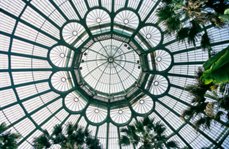|
History of Greenhouses:
Romain Times:The history of greenhouses dates back to the Roman times when a Roman Emperor, Tiberius( the second roman emperor), was very particular about eating a cucumber-like vegetable daily called an Armenian cucumber, which is actually a variety of melon. To make sure that they had this fruit available for the Emperor daily the Roman gardener’s used artificial methods (like that of greenhouse gardening) enabling them to grow every day of the year. They would plant the Armenian cucumbers in wheeled carts, allowing them to be able to wheel them to the locations that received the most sun throughout the day. This would probably be where the concept of container gardening had originated as well. At night, because of the cold night time temperatures, these garden beds on wheels would be moved inside to be kept warm. They would also be kept, when need be, in houses glazed with oiled cloth that would allow for sunlight but would retain the warmth of the suns rays. Italy:The first true greenhouses were built in Italy for the tropical plants that were brought back from the excursions of thirteenth century explorers. Originally these early greenhouses were referred to as botanical gardens. Netherlands and England:This technology soon found a home in the Netherlands and England, where plants from the tropics were also kept and studied. These greenhouses were still primitive and it took large amounts of work and effort to close them at night, not to mention the preparation in heating them for the coming winter. Balanced heat was very difficult for these early greenhouse gardeners to achieve and maintain. The first practical greenhouse was built in Holland, to grow medicinal tropical plants by a French botanist named Jules Charles. Greenhouse Progression:Early on greenhouses were reserved for the rich (it is a common misconception nowadays that they are still reserved for the rich), and as the plant sciences grew in popularity and fascination they soon found a home with the Universities. The French referred to their early greenhouses as orangeries, as they were used to keep their orange trees from freezing, and as other fruits became popular, like the pineapple, they too had special greenhouses constructed to keep them safe and warm. Famous Greenhouses around the World:As greenhouse technology improved and construction techniques evolved, there were some fascinatingly elaborate greenhouses constructed that still exist today, such as:
These heated greenhouses are absolutely amazing, and just go to show what can be achieved with greenhouse gardening. Knowing the history of greenhouses shows the simplest forms of greenhouse gardening that can be very effective. Or, as it can be today as well, be very intricate and involved. The History of Greenhouses, it shows how they have played a huge role in exploration around the world for centuries. |




